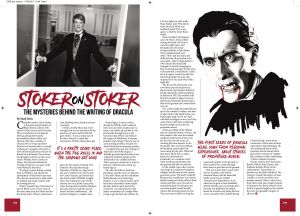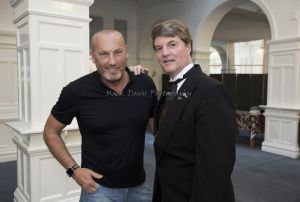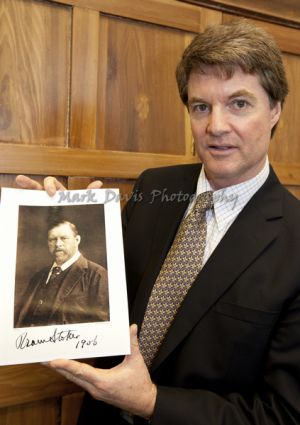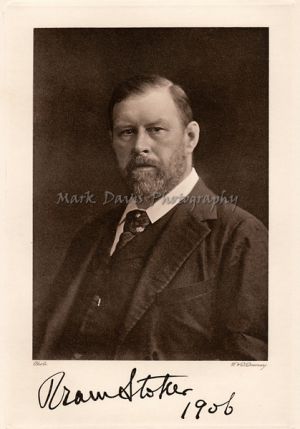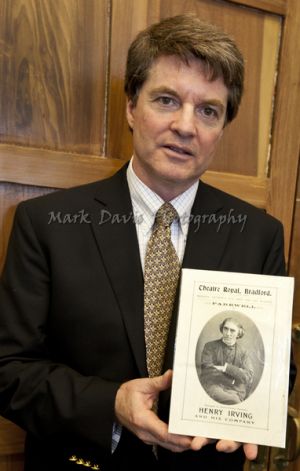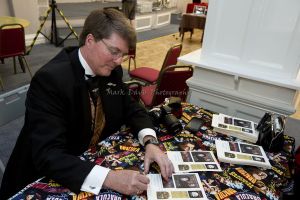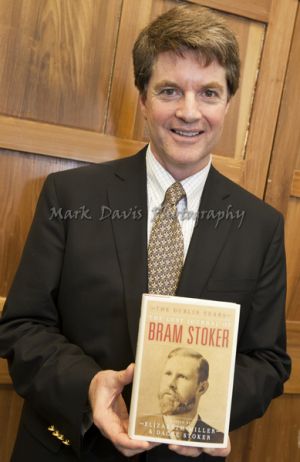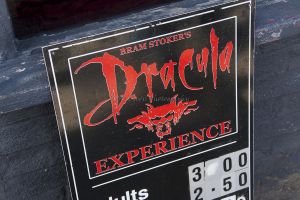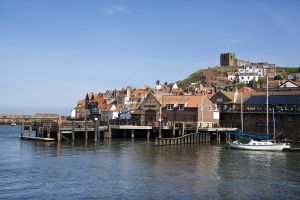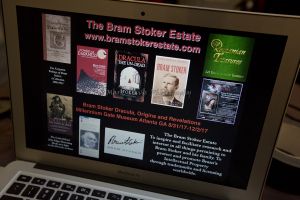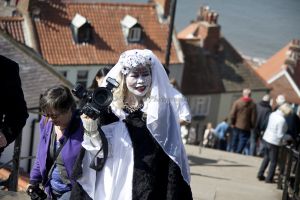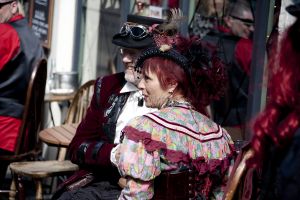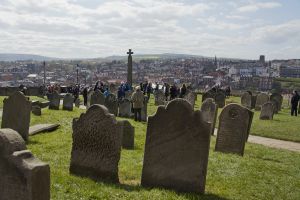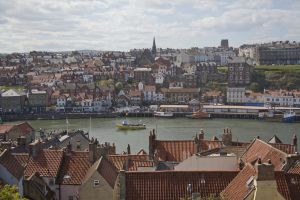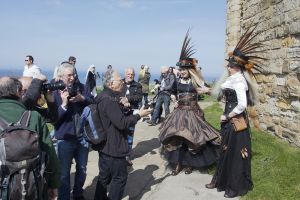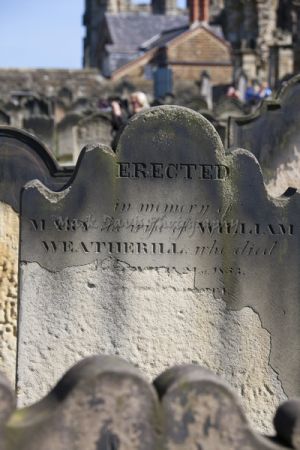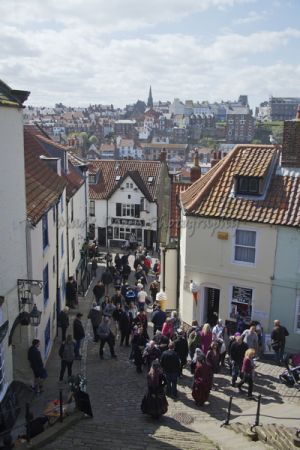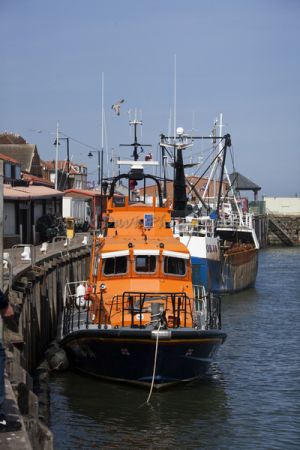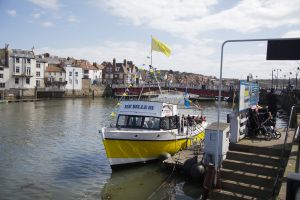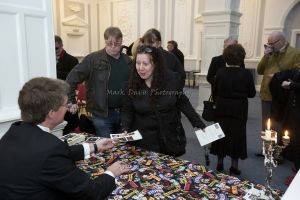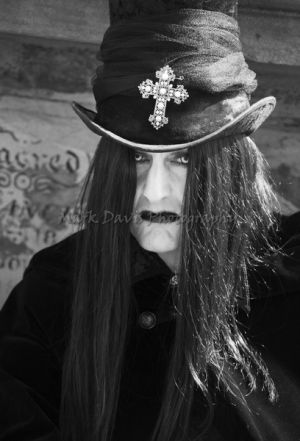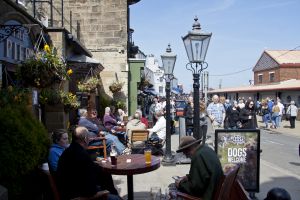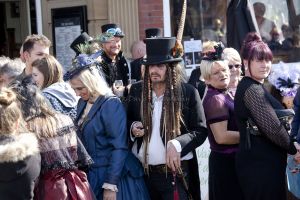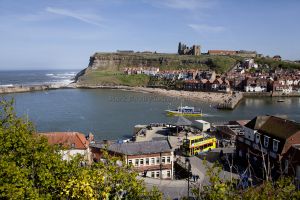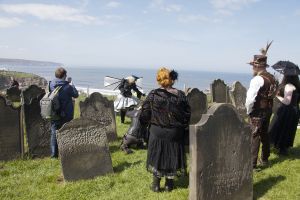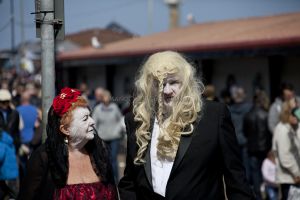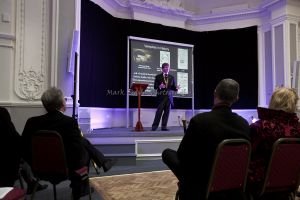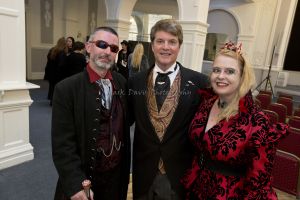Mark Davis in conversation with Dacre Stoker
Canadian author Dacre Stoker is the great-grand nephew of Bram Stoker, author of the classic Gothic horror novel Dracula. He is an authority on his famous forbear, giving multi-media presentations about Stoker and Dracula, he has written Dracula-based fiction himself, and he hosts tours to the Dracula country of Transylvania in Romania. Mark Davis chatted with him on his recent visit to Whitby, where “Stoker on Stoker, The Mysteries Behind the Writing of Dracula”, was part of the Goth Weekend festivities.
It’s great to be back in Whitby?
It’s really nice. It’s always a great feeling coming back here because I just absorb the atmosphere of what Bram may have felt when he got here to relax while on holiday and start getting creative with his writing process.
Do you feel you’ve got an Affinity to Whitby?
I do, I really feel that when I do my research here that there’s a part of Bram in me. I think that I have some of the same attraction that Bram had for this lovely town. We talk about genetics and DNA and how more then just genes are passed on, but when I come here I start thinking more clearly and more creatively.
I have realized that I think a lot like Bram did. I feel strongly that he was turned on by the presence of water and the life that goes with it. It was a major part of his life; Clontarf, Cruden Bay, Greystones, Whitby, these places got him into the mode of writing. The Demeter (the ship that brings Dracula to Whitby) is a big part of the story, Whitby is the entry point for Count Dracula, and there’s also the sinisterness of Whitby at night-time. Not wanting to scare off the tourists, but it’s a pretty scary place when the fog rolls in and the shadows get long, and you walk the narrow streets and the cobblestones…to me it’s a little bit scary, the perfect setting for a Vampire story.
He’s still very much alive here?
Bram’s legacy is more evident during the Whitby Goth weekend when you see other people come to enjoy it and dress up and feel it, and wander through town as the Victorians did, promenading. When you think of the origins of Whitby jet, it became popular when Queen Victoria wore it as mourning jewelry. It’s kind of ironic that not only is it a dinosaur relic, it’s part of a burial ritual and a mourning routine.
If you didn’t have the name Stoker, would you have been equally inspired?
I probably would have stuck with playing, teaching or coaching sport. I don’t think I really would have got into writing myself if I didn’t have the Stoker legacy. You see I initially got interested because of our collection of Bram’s books on the bookshelf in my childhood home. Their presence caused me to want to find out a little bit more about my family legacy.
My wife and I like to look into genealogy, and the more we dug into it, the more Bram and his immediate family became very interesting relatives. I was a school teacher and I have been interested in how people develop, both in sport and in the classroom. I am interested in what makes somebody tick, it helps when trying to get the best out of them. So I set my sights on what made Bram Stoker tick? Why did he write Dracula? What was inside his head? What were the experiences in his life that contributed to his writing of Dracula? This is my quest, to find the inner Bram Stoker.
The famous actor Sir Henry Irving died Bradford, 1905. You talk on inspirations and characters. While he was writing book 1890-97 he was touring with Irving.
Because of Irving Bram got to travel a lot. He went to America eight times, and thru parts of Europe. Irving was lucky to have Bram. They complemented each other. They each had traits and skills that the other needed to be successful. I think there’s a little bit of Irving in Count Dracula, the tall strong leader, the man who required a lot, the man who lived a night life.
When Irving died, Bradford wept. There’s a picture of Bram coming out of the Theatre Royal with the playbills covered up.
I’ve seen that picture, and this is the picture that depicts a moment in Bram’s life when his life changed drastically, I am sure he wept too. He’s lost a great friend, nothing was the same, it was a life-changing event for Bram and unfortunately things start to go downhill for him after that.
Do you feel almost you’re being led on a journey by Bram?
It’s possible because I haven’t systematically plotted this out. I just sort of go where instinct tells me. Just like this quote in Dracula: “There are mysteries which men can only guess at, which age by age they solve only in part”. I have stumbled on a few mysteries and been led to them by others like Hans de Roos and the 1901 Icelandic translation of Dracula. The journey is certainly interesting, I love to share these discoveries with interested fans.
Let’s talk about how Bram created his vampire? He did this between 1890-97. How did the idea first evolve in his mind? Where were the first seeds?
I believe the first seeds were from personal experience, about stories of premature burial of people during the cholera epidemic in Ireland in 1832. His mother told him how people in Sligo, her town, had been prematurely pushed into a hole in the ground and crawled their way out. That was a seed, but it wasn’t until he was actually in the British Museum library that he found the Emily Gerard essay entitled Transylvanian Superstitions. We don’t know exactly in what order he saw all these things, but then in an interview he gave to Jane Stodard, British Weekly, just two months after Dracula was published, he talked about the Gerard essay being probably the best source, and about Rev. Sabine Baring Gould writing a book about werewolves, which also involves superstition and mythology. He also mentioned eleven other countries that he found which had certain versions of vampire like creatures in their mythology; “China, Iceland, Germany, Saxony, Turkey, the Chersonese, Russia, Poland, Italy, France, and England, besides all the Tartar communities”. I haven’t found all the reference books where he found these other superstitions but obviously he did a lot of research. I think it was him sitting down and being prepared and doing the hard work to create a story with a realistic feel, combed with his own experiences and those that have existed for many years around the globe. Somewhere in between he read John Polidori’s The Vampyre, Joseph Sheridan Le Fanu’s Camilla, so it was not all his own unique creation. Other writers have done their work and created vampire in literature, but Bram refined it and took it to greater lengths as he created the most recognizable vampire of all time.
Decomposition: There were legends about people buried alive. Your still hear now where old Victorian graveyards were cleared and they lifted lids and found scratches on the inside from fingernails.
At a certain stage they had bells put up on the outside of coffins, and laws in place that in the death house, you had people lying out for two days or so with bells on fingers or toes, so if they came to they would ring, because people were scared of premature burial. I mean, what a hell of a way to go if you were buried alive.
When you think of the cholera time in Charlotte Stoker’s stories, the first people to die were the trained medical people because they were the first ones on the scene, all catching the same disease. So it’s the people who were not medical, the drunk street ladies, that were caring for the sick. What did they know about how to take a pulse or to determine if somebody’s in a catatonic state? They would just push them into the ground and take no chances. What a horrible way to go. I couldn’t imagine if you were buried alive, the panic and scratching trying to get out.
Decomposition and misunderstand plays a part… giving the impression of dead being undead?
In the Middle Ages when corpses were dug up as suspected vampires, villagers would come across a pretty gruesome scene. The body would be bloated, they would have rosy cheeks, liquid coming out of the sides of their mouth and their nose. It’s such an unusual thing for the living to see, not many people would actually witness the decomposition process because normally it goes on underground.
So when they did see it, the easiest thing to think of was that the body was not actually dead. Normally the bones are just white bones, no flesh. Now you’re beginning to see something and your mind is saying ‘What’s going on here?’ Looks like he’s just had a big meal, he is plump from eating something, that’s not normal. The next step would be to keep this suspected vampire in the ground, so they would drive a steak thru his heart to pin him to the ground.
Besides you research into your great grand uncle Bram, you have co authored two books.
I co-authored Dracula the Un-Dead (2009) was the sequel to Dracula , which picked up the action 25 years after Dracula ended, with the baby born of Mina and Jonathan. The interesting point is that there was a blood exchange between Dracula and Mina before she had the baby. So we leave the door open to what we think this boy is going to be like, what’s going on in his life?
In addition I’ve co-edited Bram Stoker’s Last Journal (2012) with Dr Elizabeth Miller, which was a journal that I found in my cousin’s attic – Bram’s great-grandson – and it basically is a commentary on his life for 11 years while he was at Trinity College in Dublin and working in Dublin Castle, and when he first moved to London. It’s a glimpse of his life and things he was interested in and cared enough about to write down. I loved working on it, since it gave me much more insight into Bram’s mind.
I’m working on a prequel to Dracula right now with a great young author called JD Barker. It’s a work of historically based fiction on all of Bram’s life and his family, but fictionalized to show that the writing of Dracula is real and it’s a warning from Bram.
